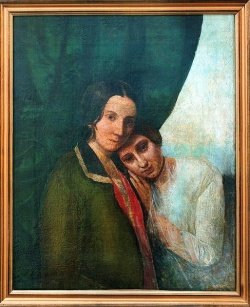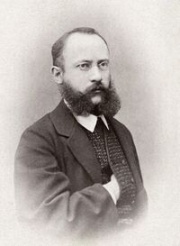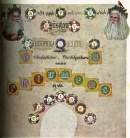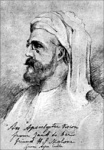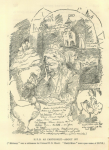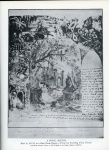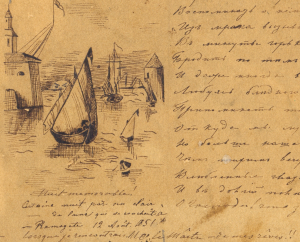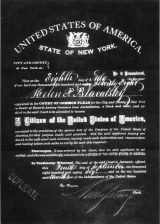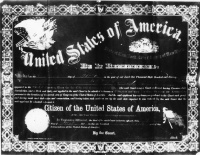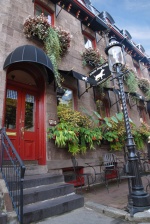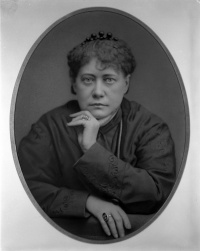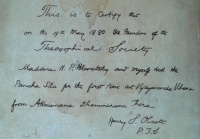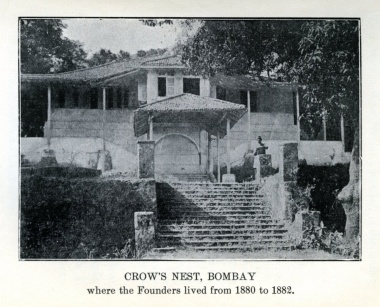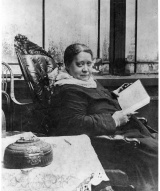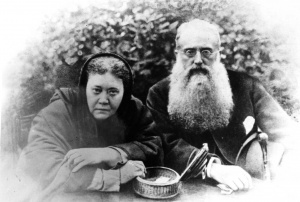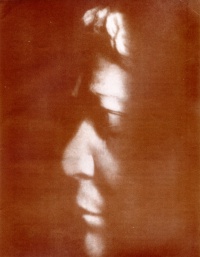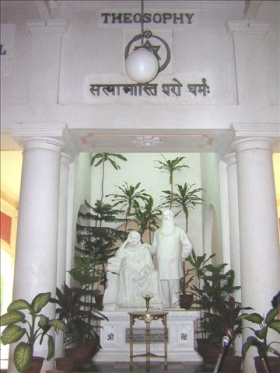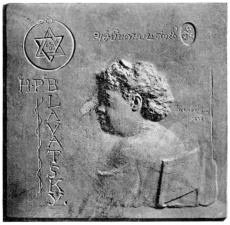Helena Petrovna Blavatsky
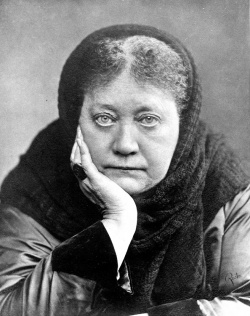
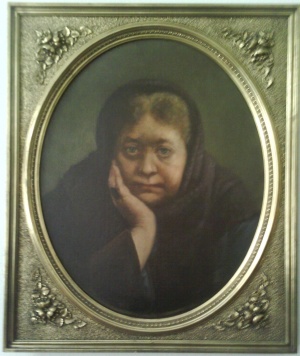
Helena Petrovna Blavatsky (Russian: Еле́на Петро́вна Блава́тская, Ukrainian: Олена Петрівна Блаватська) was was a Theosophist, writer, and traveler. She was born on August 12, 1831 (31 July, old style) in Yekaterinoslav, an administrative-territorial unit of the Russian Empire. This city is today known as Dnipro, as it is part of Ukraine.
In 1875 (together with Colonel H. S. Olcott, attorney William Quan Judge and others) she established the Theosophical Society. Blavatsky was the main source of Theosophical teachings and discussed the major themes of Theosophy in many articles and several major works, including Isis Unveiled, The Secret Doctrine, The Key to Theosophy, and The Voice of the Silence. She died in London, on May 8, 1891.
Blavatsky, widely known as HPB, was instrumental in bringing the spiritual wisdom of the East and that of the ancient Western mysteries to the modern West, where they were virtually unknown.
See also:
Early years
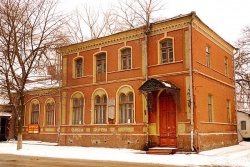
Helena Petrovna von Hahn (Russian: Елена Петровна Ган, Ukrainian: Олена Петрівна Ган) was the first child of Colonel Peter Alexeyevich von Hahn (1798-1873) and Helena Andreyevna Hahn (née de Fadeyev), a well-known social novelist. She was born at Ekaterinoslav in Southern Russia on August 12, 1831 (or July 31 in the Julian Calendar, then current in Russia). Having been born on the seventh month of the year she was called by the servants and locals "the Sedmitchka" (a possible alternate spelling--Sedgmika), an untranslatable term, meaning one connected with number Seven (other pet names she had were "Lelinka" and "Lyolya", diminutive of Helena).
Although no official record has ever been produced of the exact time of her birth, it has been determined with sufficient accuracy by astrological rectification, based on various important events in H.P.B.’s life, to have been 1:42 A.M., local time, which, equated for Greenwich, would be 11:22 P.M., on August 11th, 1831.[1]
Helena was born prematurely. As in 1831 Russia was suffering from a widespread epidemic of cholera that had ravaged several members of her parents’ household, there was fear for the infant’s life. An immediate baptism took place, during which a child who fell asleep holding a candle in the first row behind the officiating priest set fire to his robes during the ceremony.
Helena had a sister Vera Petrovna (April 29, 1835 - 1896) and a brother, Leonid (June, 1840 - November 9, 1885).
According to Vera P. de Zhelihovsky, her mother, at the time, was worried about the destiny of her elder daughter, "gifted from childhood by outstanding features".[2]
The first ten years of Helena’s life were spent in frequent changes from one place of residence to another, partly due to the fact that her father’s battery of Horse-Artillery was being transferred from place to place, and partly because of the precarious health of her mother.[3] Helena’s mother died on July 6, 1842 at the age of 28 of galloping consumption. Before her death, her mother said:
Well! Perhaps it is for the better that I am dying: at least, I will not suffer from seeing Helena’s hard lot! I am quite sure that her destiny will be not womanly, that she will suffer much".[4]
Her father would die was on July 27, 1873, after only three days of illness, while HPB was in New York ready to start her public career.
After her mother’s death, Helena’s grandfather Andrei Mikhailovich and Grandmother Helena Pavlovna (who was an accomplished amateur scientist) took the children to Saratov, where they had quite a different life. Fadeyev’s house was visited by Saratov’s intellectuals.
Helena was clairvoyant from early childhood. In occasions she saw the majestic figure of a Hindu in a white turban, whom she called her "Protector", since he had saved her in dangers. One of these accidents took place when she was a young child. Wanting to examine a picture hanging high up on a wall, she piled up a couple of tables and a chair and started climbing. When she reached the painting she lost her balance and remembered nothing else. She then found herself safe on the floor, both tables and the chair standing in their usual places, with the trace of a small hand left on the dusty wall under the picture. Another instance took place when she was 13 years old. She was riding a horse which became frightened and ran away. She fell from her seat, her foot got caught in the stirrup and hung on to it. Instead of being killed she felt someone’s arms around her body supporting her until the horse was stopped.[5]
First marriage
The Winter season of 1848-49 was spent at Tiflis in the mansion of the old Princes Chavchavadze. Striving for full independence 17-year old Helena became betrothed to vice-governor of Erevan, Nikifor Vladimirovich Blavatsky (1810-1873?), who was about 40 years old. Their wedding ceremony took place on July 7, 1849. In October Helena left her husband and started on horseback for Tiflis to rejoin her relatives.[6][7] Nikifor Blavatsky tried to obtain a divorce on the ground that "his marriage had never been more than a form." His attempt failed, however, owing to the fact that Russian law at the time regarded divorce with disfavor.
It is not certain when Nikifor died, but newspapers indicated that it was about 1873.[8] In Helena's scrapbook there is a cutting from a newspaper talking about her life, where we find the sentence: "For many years they [Helena and Nikifor] resided together at Odessa, and finally a legal separation was affected." To this, HPB added two notes. The one commenting on her stay with her husband "for many years" said: "a lie—was with him but for three weeks." To the second phrase: "finally a legal separation was affected" she added "legal, because he died." The name and date of the newspaper do not appear in print, but H.P.B. wrote in ink above the cutting: "From the N. Y. Mercury, Jan. 18, 1875."[9]
Travels
Shortly after her marriage Mme. Blavatsky began more than 20 years of extensive travel all over the world, which is extremely difficult to trace in any coherent manner. Between 1848 and 1875 she went around the world three times in search of wisdom about the nature of life and the reason for human existence. This brought her into contact with mystic traditions the world over. Since she traveled alone, this period of Blavatsky’s life is difficult for her biographers to document, although she wrote and talked about her adventures in later years. N. A. Fadeyeva reported that only her father knew where his daughter was, and from time to time would send money to her.
Music, art, and languages
Mme. Blavatsky was early trained in the music, arts, and languages expected of young women in her class. She spoke Russian at home, and learned French and English from her governess, becoming perfectly proficient in all three languages. An American newspaper reported, probably with a bit of exaggeration, "Her knowledge of languages is extraordinary. She converses and writes fluently in Russian, Polish, Romaic [modern Greek], Low Dutch, German, French, Spanish, Italian, Portuguese and English."[10]
Colonel Henry S. Olcott wrote of her musical ability:
She was a splendid pianist, playing with a touch and expression that were simply superb. Her hands were models – ideal and actual – for a sculptor and never seen to such advantage as when flying over the keyboard to find its magical melodies. She was a pupil of Moscheles, and when in London as a young girl, with her father, played at a charity concert with Madame Clara Schumann and Madame Arabella Goddard in a piece of Schumann's for three pianos. During the time of our relationship she played scarcely at all. Once a cottage piano was bought and she played on it for a few weeks, but then it remained closed ever after until sold, and served as a double bookshelf. There were times when she was occupied by one of the Mahatmas, when her playing was indescribably grand. She would sit in the dusk sometimes, with nobody else in the room beside myself, and strike from the sweet-toned instrument improvisations that might well make one fancy he was listening to the Gandhavas, or heavenly choristers. It was the harmony of heaven.[11]
Her cousin, Count Witte, in his Memoirs, referred to this musical talent at some length, and William Kingsland gave this account:
I well remember on one occasion, on a visit by her to my house in London in 1889, she sat down at the piano and played Schubert's Erl-König, to to my great surprise and delight, as I had never even heard that she had ever been a pianist.[12]
Clearly she sought out pianos whenever they were available. A. P. Sinnett reported "finding her at the piano in the ball room of Mr. Hume's house" in India.[13]
Drawing was a skill that HPB demonstrated frequently in her Scrapbooks. She enjoyed the company of artists such as William R. O’Donovan, Thomas Le Clear, Albert Rawson, Hermann Schmiechen, Monsieur Harrisse, Reginald Machell, Isabelle de Steiger, and Walter Paris. Several artists she entertained in New York were members of the Tile Club. She was equally proficient in pencil sketches of landscapes, portraits, and caricatures such as these:
Meeting Master Morya
In her Sketchbook, now in the Adyar Archives, Mme. Blavatsky says that she met her Teacher, Master M., in the physical body for the first time on her twentieth birthday at Ramsgate, a seaside town some 70 miles from London. She wrote in French,
Nuit mémorable! Certaine nuit par au clair de lune qui se couchait a Ramsgate 12 Aout, 1851(*) lorsque je recontrais M. le Maître – de mes rêves!!
(*) Le 12 Aout c’est Juillet 31 style russe jour de ma naissance – Vingt ans!
An English translation provided in the Cranston book reads, "Memorable night! On a certain night by the light of the moon that was setting at Ramsgate on August 12, 1851,(*) when I met M. the Master of my dreams!! (* August 12 is July 31 in the Russian calendar, the day of my birth – Twenty years!)"
However, she told Countess Constance Wachtmeister that “Ramsgate” was a blind, and that this took place in Hyde Park, London. She told A. P. Sinnett that this was "in the year of the first Nepal Embassy", that is, in 1850.
It is almost certain that H.P.B. was in London in the Summer of 1854, because she says that she met her Master again "in the house of a stranger in England, where he had come in the company of a dethroned native prince". This was undoubtedly Prince Dhuleep Singh, Mahârâja of Lahore.[14]
In Tibet
The subject of Mme. Blavatsky’s stay in Tibet is wrapped in considerable mystery, as she kept the specific information secret. In 1884 she wrote the following:
I have lived at different periods in Little Tibet as in Great Tibet, and . . . these combined periods form more than seven years. Yet, I have never stated either verbally or over my signature that I had passed seven consecutive years in a convent. What I have said, and repeat now, is, that I have stopped in Lamaistic convents; that I have visited Tzi-gadze, the Tashi-Lhünpo territory and its neighbourhood, and that I have been further in, and in such places of Tibet as have never been visited by any other European, and that he can ever hope to visit.[15]
At the time, the term "Tibet" was used in a general manner that included not only Tibet proper, but also regions such as Ladakh (then known as Little Tibet). Sometime during 1852 she attempted to get into Tibet through Nepal. This first attempt failed through what she believed to be the opposition of the British Resident. When she tried to cross the Rangit river, she was seen and brought back.[16]
In 1855 she and some friends formed a plan to penetrate Tibet under various disguises. According to Mr. Sinnett, H.P.B. crossed into Tibetan territory, with the help of a Tartar Shaman who was on his way home to Siberia, while the others were prevented from carrying out their plan.[17]
It is presumed that sometime in 1868 H.P.B. went via India to some parts of Tibet. It is on this journey that she met Master K.H. for the first time, and lived in the house of his sister at Shigadze.[18]
On November 11, 1870, her aunt, Miss Nadyezhda Andreyevna de Fadeyev, received the first known letter from Master K.H. stating that H.P.B. was well and would be back with the family soon.
Société Spirite
In 1871 Mme. Blavatsky embarked for Egypt from Greece, where she had seen Master Hillarion. The ship was carrying guns and gunpowder as a protection against pirates and on July 4, 1871, its powder magazine blew up, with a considerable loss of life. H.P.B., however, was uninjured. She eventually reached Alexandria with hardly any means at all. In October or November she went to Cairo where she met Emma Coulomb (then still Miss Emma Cutting) who was able to loan her some money for the time being.[19]
It was here that H.P.B. made a first attempt at investigating and explaining the nature of phenomena. For that purpose, she formed the Société Spirite (“Spiritist Society”) for the investigation of the Spiritism of the French occultist Allan Kardec. It would appear that this was done against the advice of Paulos Metamon, a well-known Coptic mystic and occultist with whom she was in touch at the time.[20] Her sister Vera de Zhelihovsky, who was in correspondence with her during these years, wrote that H.P.B. chose to start in this way “since there was no other [philosophy available]; to give people a chance to see for themselves how mistaken they were. She would first give room to an already established and accepted teaching and then, when the public would see that nothing was coming out of it, she would then offer her own explanations”.[21]
However, the Société Spirite failed within a fortnight as Blavatsky could not find honest and qualified mediums to do the kind of research she had envisioned.
Life in the United States
Probably in June, 1873, while in Paris, Mme. Blavatsky received an order from her Master to go to New York. She arrived in New York on July 8 and began to work designing illustrated advertising-cards. She also seems to have tried some ornamental leather work, artificial flowers, and cravats.
In July, 1874, Col. Henry S. Olcott became interested in Spiritualism and decided to investigate and report as a journalist the spiritualistic phenomena taking place at the Eddy farmhouse in Chittenden, Vermont. He went back to New York after a few days and published an account for the New York Sun. On September 17 he returned to Chittenden for further investigation and on October 14, acting on instructions received, HPB joined him, quickly becoming friends.
Through her occult training, Mme. Blavatsky had develop psychic abilities that allowed her to command the elementals (certain invisible powers of nature) through which she could perform many phenomena. Col. Olcott began to witness some of these abilities and naturally became very interested in this. As she began to instruct him in the Occult Science and the Esoteric Philosophy, the two started working together in connection with the Spiritualistic movement in the US. During this time, HPB performed at will many phenomena normally ascribed to “the spirits,” and published articles in different spiritualistic journals explaining the origin and nature of these psychic incidents, in ways that contradicted many of the Spiritualists' theories. Most spiritualists were not pleased with HPB’s attempt to reform, sometimes quite radically, their beliefs.
See also: Phenomena
American citizenship
On September 22, 1874, Mme. Blavatsky signs a U.S.A. Government application form expressing her intention to become naturalized.
On July 8, 1878, "Helen P. Blavatsky" appeared in the Court of Common Pleas in New York City and completed the process of applying for citizenship in the United States. She was the first Russian woman to be naturalized as an American citizen.
In 1978, Boris de Zirkoff stated that her naturalization papers were in the hands of Geoffrey Watkins at the time,[22] who was the son of John Watkins, a personal friend of Blavatsky.[23]
Second marriage
On April 3, 1875, a few months before founding the Theosophical Society, Mme. Blavatsky married a Georgian importer living in Philadelphia, Michael C. Betanelly. The wedding was conducted by Rev. William H. Furness at the First Unitarian Church of Philadelphia.[24] She agreed to this marriage after her suitor conceded that she could retain her name and independence, and that it was a marriage in name only. Colonel Olcott was astonished at the situation and she later told him that the situation resulted from karmic complications from past lives.[25] The marriage broke off after several months and Betanelly sued for divorce, which was finally granted on May 25, 1878, with William Q. Judge acting as Blavatsky's counsel.
The White Dog
In 1875 Mme. Blavatsky resided at 3420 Sansom Street, in Philadelphia, PA. During the last days of January, she injured her leg and her knee. By the middle of April John King cured the leg, but the trouble returned owing to lack of rest. By May her leg grew worse, becoming paralyzed and doctors and surgeons said the leg should be amputated. She dismissed their advice saying,
Fancy my father's daughter--on a wooden leg--fancy my leg going in the spirit land before me![26]
A message precipitated from John King claimed that he would cure it. On June 3, at midnight, HPB laid cold, pulse-less, and rigid; her injured leg had swollen to twice the natural size and had turned black. Her physician had given her up and her attendants thought her to be dead. However, within a few hours, the swelling subsided and she revived. Her leg was cured after two days of cold poultices and having a white pup laying at night across it. The story of the white dog has entered into Philadelphia lore with a restaurant called "The White Dog Cafe" located since 1983 in the building where Blavatsky lived.
During that time HPB was very ill and, according to her husband Michael C. Betanelly, she sometimes appeared to be "dead". As it would appear from Master Serapis' letters to Col. Olcott she underwent a serious trial or initiation. By the end of June, HPB had recovered fully.
The Miracle Club
While living in New York, Mme. Blavatsky started publishing some articles and letters on spiritualism, magic, and occultism. According to Col. Olcott this and "the stories that were afloat about her magical powers, and our several affirmations of the existence of non-human races of spiritual beings, drew into our acquaintanceship numbers of bright, clever people of occult leanings".[27] At this time Mme. Blavatsky recorded the following in her scrap-book:
An attempt in consequence of orders received from T*** B*** through P*** personating John King. Ordered to begin telling the public the truth about the phenomena and their mediums. And now my martyrdom will begin! I shall have all the Spiritualists against me, in addition to the Christians and the Sceptics. Thy will, oh M., be done. H.P.B.[28]
In May 1875 it was decided to form a private investigating committee under the title of the "Miracle Club" where the phenomena of spiritualism would be studied, tested, and demonstrated; "All the manifestations, including materialisations, to occur in the light, and without a cabinet".[29] This attempt, however, failed, mainly because the medium that was to be involved wanted to earn money from this endeavor, something HPB always opposed.
- See also Miracle Club
Founding of the Theosophical Society
In July 1875, HPB wrote in her scrapbook:
Orders received from India direct to establish a philosophico-religious society and choose a name for it, also to choose Olcott.[30]
On September 7, sixteen or seventeen people joined HPB in her rooms at 46 Irving Place to hear a lecture by George H. Felt on "The Lost Canon of Proportion of the Egyptians, Greeks and Romans." The talk was enthusiastically received and H. S. Olcott wrote on a slip of paper, "Would it not be a good thing to form a society from this kind of study?" He handed it to W. Q. Judge to pass it to HPB, who nodded in assent.[31]
At subsequent meetings bylaws were decided upon and officers were elected, with Col. Olcott as President, G. H. Felt and Dr. Seth Pancoast as Vice-Presidents; Madame Blavatsky, Corresponding Secretary; and W. Q. Judge as Counsel to the Society.
On November 17, seventy days after the formation of the Society was proposed, Col. Olcott gave his inaugural address as President-Founder of the newly formed Theosophical Society.
See also Founding of the Theosophical Society.
The "Lamasery"
Since June 1876 till December 1878 Mme. Blavatsky and Col. Olcott lived in an apartment situated at 302 West 47th Street in New York. Known as the "Lamasery", the place became the unofficial headquarters of the newly formed Theosophical Society and a center of attraction for people interested in Occultism, Kabbalah, Spiritualism, Platonism, as well as those curious about phenomena. Col. Olcott and Mr. Judge were nearly always present, and, after the departure of the visitors would remain far into the night immersed in study and discussion.
See also The Lamasery.
Isis Unveiled
H. P. Blavatsky's first major literary effort was Isis Unveiled, a critical response to the growing materialism in both scientific and religious institutions. The book was started in 1875, a few months before the formation of the Theosophical Society, although at the time HPB did not know what was to become of the growing pile of manuscripts.
Described as "A Master-Key to the Mysteries of Ancient and Modern Science and Theology," the book was published in two volumes on September 29, 1877, quickly becoming a classic in occult literature. Two large editions of this "epoch-making" work were sold immediately, and new editions have been appearing ever since.
Life in India
On December 18, 1878, five months after being officially naturalized as a U.S. citizen, Mme. Blavatsky (along with Col. Olcott, Edward Wimbridge, and Rosa Bates) left for India via England. She would not return to the country again. The party arrived in London on January 3, 1879, and spent two weeks at the house of Dr. and Mrs. Billing. They sailed for Bombay on January 19.
Arriving at Bombay
Mme. Blavatsky and the party arrived in Bombay on February 16, 1879. In October of this year she started publishing The Theosophist. On December 4 the Founders visited A. P. Sinnett, editor of The Pioneer, who would become an important figure in the early Theosophical Society. A second visit was paid in 1880 where Mme. Blavatsky performed many wonderful phenomena that Mr. Sinnett described in his book The Occult World.
During 1880 Mme. Blavatsky suffered many personal attacks concerning her identity and antecedents. Being Russian and earning money from publication of stories in Russian newspapers, the British government feared she was a Russian spy.
Taking Pansil
On May 19, 1880, at the invitation of two head Buddhist monks of Ceylon (Sri Lanka), Mme. Blavatsky and a group of Theosophists went to the island. Here they "took Pansil", that is, they formally identified themselves with Buddhism by reciting the Five Precepts (pancha-sila) at the Vijayananda Vihara, in Galle.
Col. Olcott certified this in his own handwriting:
"This is to certify that on the 19th May 1880 the Founders of the Theosophical Society Madame H. P. Blavatsky and myself took the Panchasila for the first time at Vijayananda Vihara from Akmemana Dhammarama Thera."
"Crow's Nest" period
By the end of December 1880, after their second visit to the Sinnetts, Mme. Blavatsky and Col. Olcott moved to a spacious house on the hill of Breach Candy, Bombay, nicknamed the "Crow's Nest". This became a great center of Theosophical activity, phenomena, and visitations by the Masters of Wisdom.
In July 1882 Mme. Blavatsky traveled incognito to go into Sikkim. At about thirty miles into Sikkim territory she met physically Masters M. and K.H. with whom she spent two days. The latter, wrote about this in one of his letters:
I do not believe I was ever so profoundly touched by anything I witnessed in all my life, as I was with the poor old creature’s ecstatic rapture, when meeting us recently both in our natural bodies, one — after three years, the other — nearly two years absence and separation in flesh. Even our phlegmatic M. was thrown off his balance by such an exhibition — of which he was chief hero. He had to use his power, and plunge her into a profound sleep, otherwise she would have burst some blood-vessel including kidneys, liver and her “interiors” — to use our friend Oxley’s favourite expression — in her delirious attempts to flatten her nose against his riding mantle besmeared with the Sikkim mud! We both laughed; yet could we feel otherwise but touched?[32]
Adyar Period
On April 23, 1882, the Founders arrived by ship at Madras, where they met T. Subba Row, and others. On May 31 they were taken to see a piece of property as a possible new headquarters for the Theosophical Society. When Mme. Blavatsky saw the Estate she declared "Master wants this purchased".[33]
On December 17 Mme. Blavatsky and Col. Olcott left Bombay by train heading for Adyar, accompanied by the Emma and Alexis Coulomb, Damodar, "Mr. Deb", Dora Swami Naidu, and five Hindu servants. They arrived on the 19th, 1882.
In 1883 she passed most of her time editing The Theosophist (which was the main source of Theosophical teachings at the time) and answering correspondence. It also fell to her to take charge of both chelas and lay chelas.[34]
In the second part of the year she spent about three months in the "Blue Mountains" (Nilgiri Hills) investigating the primitive Toda people living there. Her account was eventually published in book form under the title of The People of the Blue Mountains.
Visiting Europe
At a council meeting on January 20, 1884, it was decided that Mme. Blavatsky should accompany Col. Olcott on his trip to Europe, partly for reasons of health. Before leaving the President issued a special order designating some members of the General Council to act as a Board of Control during his absence to take care of the official business.
They left Adyar and reached Marseilles on March 13. HPB stayed in France for about three weeks, mostly in Paris. On April 7, she unexpectedly appeared at the election of officers in the London Lodge.
On August 17 she visited the Gebhard Family at Elberfeld, Germany. It was here that she heard from Damodar K. Mavalankar in Adyar about the attack from the Missionaries, incited by Emma Coulomb, accusing HPB of having fraudulent phenomena.
Mme. Blavatsky left for India on November 1, 1884, accompanied by Isabelle Cooper-Oakley and her husband. They were joined by C. W. Leadbeater at Port Said, in north east Egypt. After stopping in Cairo, they went to Ceylon (Sri Lanka) and joined Col. Olcott there. They arrived at Adyar on December 17, 1884.
The Hodgson Report
In 1884, while the Founders were in Europe, the members of the Board of Control at Adyar could not tolerate Emma Coulomb any longer. They asked her to leave and she planned to take revenge. She and her husband Alexis went to the missionaries in Madras (now Chennai) and organized an attack on Mme. Blavatsky.
When HPB arrived at Madras on December 17, she received a tumultuous reception. She spoke in Pachaiappa's Hall packed with supporters, and declared that Emma Coulomb's letters, as they stand, had not been written by her.
The Society for Psychical Research (S.P.R.) decided to send young Richard Hodgson to Adyar to investigate Mme. Blavatsky's phenomena, the production of the Mahatma Letters, and the Coulomb's accusations. He arrived at Adyar in November, 1884, were he was friendly received. However, he began to be deceived by Emma and her husband into believing that she had faked them.
In April 1885 Hodgson returned to London. At the General Meeting of the S.P.R. held on June 24 he presented a 200-page report declaring that Mme. Blavatsky was one of the most gifted, ingenious and interesting impostors in history.
Although her reputation was seriously damaged due to this report, the next years of her life can be regarded as the most productive in her role as a spiritual teacher.
In January 1885, while in Adyar, Mme. Blavatsky became seriously ill. One night when she was about to die Master M. came and laid his hands upon her to bring her back from death.[35] Unable to perform any administrative duties due to her health, on March 21 1885 she resigned as Corresponding Secretary of the Theosophical Society.
Eventually, partly because of her health and partly to diffuse the effects of the accusations brought by the Coulombs, Mme. Blavatsky was "sent to Europe", in spite of her protests.
That this move had been contemplated by the Masters for some time can be ascertained from a letter Master K.H. wrote to A. P. Sinnett in October, 1884. In reference to Mme. Blavatsky, he stated:
She is permitted to retire for three reasons (1) to disconnect the T.S. from her phenomena, now tried to be represented all fraudulent; (2) to help it by removing the chief cause of the hatred against it; (3) to try and restore the health of the body, so it may be used for some years longer.[36]
Later researches such as those made by Dr. Vernon Harrison, an expert on forgery, and Walter A. Carrithers, Jr. (pen name of Adlai E. Waterman) showed that the Hodgson's research was faulty and biased.
See also: Hodgson Report.
Life in Europe
On March 31, 1885, Mme. Blavatsky sailed away from India, never to return. With her went Babaji, Dr. Hartmann, and Mary Flynn to look after her.
She stayed in Torre del Greco, Italy, for about three months, and in August decided to go to Wurzburg, near Munich, Germany. With the regaining of her health she started to become involved in the administration of the TS in Europe and she started working in a systematic way on her next book, The Secret Doctrine.
The Secret Doctrine
In May 1879, soon after moving to India, Mme. Blavatsky started designing a new book on Theosophy that would eventually become The Secret Doctrine.
In January 1884 the Supplement to The Theosophist published an advertising announcing "a New Version of Isis Unveiled", which was to be published in monthly. Although Mme. Blavatsky had some written material to start the monthly installments, this never came to fruition in the way planned, due to ill-health, her travel to Europe, and the Coulomb affair.
In the fall of 1885, a few months after moving to Wurzburg, Germany, HPB started working steadily on its writing. The Countess Wachtmeister moved with HPB to help her in this endeavor. As the writing of the book developed with the help of Masters M. and K.H., HPB realized it was much more than a rewriting of Isis Unveiled. In a letter to A. P. Sinnett she said she felt that this could vindicate the Theosophical Society after the unfavorable Report that Hodgson made.[37]
In the spring of 1886 she sent a preliminary manuscript of the first volume to Adyar, where T. Subba Row was supposed to read it and contribute in what had to do with Hindu philosophy. However, he refused to do so. HPB moved to Ostende, Belgium, where she continued working on the book, and finished it after moving to London, where he had the help of a group of young members. The First Volume of The Secret Doctrine came off the Press on October 20, 1888, while the Second Volume was out towards the end of the year.
Bright's disease
By the end of March 1887, in Ostende, HPB fell gravely ill with a kidney infection. She was not expected to live. Master M. came at night and asked her if she wanted to be freed from the body or live, amidst much suffering, finish The Secret Doctrine and do some more work for Theosophy in Europe. She agreed, although regretfully. In a letter to J.G. Buck she wrote: "No luck! Saved once more and forced to accept a new lease of life."[38]
Move to London
Before Blavatsky's health crisis, Archibald and Bertram Keightley had been asking her to move to London, where she would find a band of devoted young workers to help her in her work. Blavatsky agreed, and soon after her recovery, on May 1, 1887, they went to Ostende to help her move. Blavatsky related this in her characteristic humorous way:
A deputation from London came to Ostende, packed me up and brought me over, kidneys, paralysed legs and all. A pretty piece of luggage![39]
She settled with a few devoted friends in Lansdowne Road, Notting Hill, in September 1887,[40] where a group of earnest students took care of her and helped her finish and publish her greatest work, The Secret Doctrine.
Blavatsky Lodge
Soon after Blavatsky arrived in London, the group of students that had gathered around her convinced her of the need to form a TS Lodge. This was done, and they called it "The Blavatsky Lodge of the Theosophical Society". In addition, they decided to form a Theosophical Publishing Company and start a Theosophical journal they daringly called Lucifer, with HPB and Mabel Collins as editors. HPB wrote many articles for this.
After the publishing of The Secret Doctrine the Lodge met regularly to discuss with HPB any obscure points they found in its first volume. The dialogues they held were partially published under the title Transactions of the Blavatsky Lodge and later a complete version was published as The Secret Doctrine Commentaries. In these meetings the content of another important book by HPB, The Key to Theosophy was also discussed before its publication.
Esoteric Section
On October 9, 1888, as a response to the demand by many earnest members to have esoteric teachings given by H. P. Blavatsky, Col. Olcott agreed to form the "Esoteric Section of the Theosophical Society" with Mme. Blavatsky as its responsible head.
In August 1890 she formed an "Inner Group" of this Section mainly with some of her students living in London at the time. The group held its meetings weekly in HPB's place, at 19 Avenue Rd, in a room specially built for it. Participants would ask questions in regards to the Esoteric Philosophy or the spiritual practice and HPB would answer.
The Voice of the Silence
In July, 1889, Mme. Blavatsky went to Fontainebleau, France, for a few week's rest. There she wrote most of the material that would turn into the mystical Theosophical work known as The Voice of the Silence. This book is a translation of three treatises contained in a secret work, The Book of the Golden Precepts, which she had learned by heart during her training in Tibet.
During this time HPB received a visit from the newly joined Herbert Burrows and Annie Besant. In regards to the writing of this book, Mrs. Besant said:
She wrote it swiftly, without any material copy before her. I sat in the room while she was writing it. I know that she did not write it referring to any books, but she wrote it down steadily, hour after hour, exactly as though she were writing either from memory or from reading it where no book was and in the evening made me read it aloud to see if the 'English was decent.' Herbert Burrows was there, and Mrs. Candler, a staunch American Theosophist, and we sat round HPB while I read. The translation was in perfect and beautiful English, flowing and musical; only a word or two could we find to alter, and she looked at us like a startled child, wondering at our praises—praise that any one with the literary sense would endorse if they read that exquisite prose poem.[41]
Writings
There exists no definite evidence that Mme. Blavatsky had ever published any articles, essays or letters to editors prior to October, 1874, although there are statements that seem to indicate that her literary work began much earlier in life. Besides the books she wrote, for much of her adult life HPB supported herself by writing travelogues and stories for Russian periodicals.
For a list of her books and other writings, see Blavatsky writings.
Death
In April, 1891, a very serious epidemic of influenza struck London. Practically the entire staff at 19 Avenue Rd. was affected, with three of them being at death's door. On April 25th, H.P.B. had a very high fever. On the 30th, she developed an abscess in her throat, and then another on the bronchial tubes, and became progressively weaker. On May 6 she somewhat improved and managed to walk into her sitting room, although she said she felt she was dying. However, on May 8, at 11 a.m., H.P.B. grew worse. A nurse, Miss Black, was present, along with several of the Inner Group. Seated in her chair, she passed away at 2:25 p.m., GMT. Miss Laura Cooper was standing behind the chair, while Walter Gornold knelt holding her right hand.[42][43] Mr. Wright "knelt beside her holding her left hand, and as she passed away took the ring from off her fourth finger."[44] The Countess Constance Wachtmeister and Isabel Cooper-Oakley arrived just after she passed. Miss Cooper left a detailed account of the event.[45]
H.P.B. had left instructions that "no parade or show of any kind should be made over her body."[46] Her body was cremated at Woking Crematorium, Surrey, on May 11, 1891. G. R. S. Mead, General Secretary of the European Section and H.P.B.'s private secretary, addressed the small assembly of officers, staff, and friends, and then the ashes were returned to her own rooms.[47]
Between May 8 and 9 Col. Olcott had received three distinct warnings about Mme. Blavatsky's passing. He had received a cablegram about the fact on May 10.
On July 9, 1891, the First Annual Convention of the European Branches was held in London. W. Q. Judge offered a resolution for the creation of an "H.P.B. Memorial Fund". Col. Olcott, as Chairman, suggested the partition of H.P.B.'s ashes. Some of the ashes are buried under the Blavatsky and Olcott statues in the Adyar headquarters that they had established in 1882.
Tributes and memorials
Almost every year, the Theosophical Society in England sponsors one of its Blavatsky Lectures, delivered by some of the best speakers in the Theosophical world.
The first Blavatsky Lodge was in London, but similar names have also been adopted by groups in Sydney, Auckland, Berlin, Brussels, Colombia, Vancouver, Mumbai, Richmond (BC), and at least seven groups in the Theosophical Society in America. The name Blavatsky Hall has been used in London, Mumbai, Chennai, Los Angeles, San Diego, and San Francisco. Blavatsky Avenue is found in Jakarta and in Adyar, Chennai. The Blavatsky Study Centre is at the Mt. Helena Retreat near Perth, Australia.
H. P. Blavatsky House-Museum in Dnepropetrovsk, Ukraine, is a museum located in the house in which HPB was born.
The H. P. B. Library in Canada was founded by Alice L. Cleather, who also helped establish the Blavatsky Association that existed from 1923 to 1945.
A brief summary of her continued influence in many countries can be found at "H.P.Blavatsky's heritage in the modern world".
Fictional and dramatic accounts
Madame Blavatsky continues to fascinate modern writers, and is frequently mentioned in plays, popular fiction, Web-based fan fiction, and blog postings. Here are some examples:
- Serra, Francesca Serra. La grande Blavatsky. 2016. Italian novel.
Paintings and sculptures of HPB
American sculptor William R. O’Donovan created a bronze medallion of Madame Blavatsky while the Founders were still in New York. It appeared as the frontispiece in the first volume of Old Diary Leaves.
See also Blavatsky photographs and portraits
Additional resources about HPB
For a listing of Helena Petrovna Blavatsky's writings, including digital versions, see Blavatsky writings.
Biographies
Numerous biographies have been written. These are some of the most significant:
- Butt, G. Baseden. Madame Blavatsky. London: Rider & Co., 1925. Has careful annotations of phenomena.
- Cranston, Sylvia [Anita Atkins]. H. P. B. The Extraordinary Life and Influence of Helena Blavatsky, Founder of the Modern Theosophical Movement. New York: TarcherPerigee, 1993. Available at Theosophical University Press. This work is probably the most complete and thoroughly documented biography
- Goodrick-Clarke, Nicholas. Helena Blavatsky. Berkeley: North Atlantic Books, 2004.
- Lachman, Gary. Madame Blavatsky: The Mother of Modern Spirituality. New York: Jeremy P. Tarcher/Penguin, 2012.
- Meade, Marion. Madame Blavatsky: The Woman Behind the Myth. New York: Putnam, 1980.
- Williams, Gertrude Marvin. Priestess of the Occult. New York: Alfred A. Knopf, 1946. This biography is overtly hostile and is known to have numerous errors of fact and interpretation.
- Whyte, Herbert. H. P. Blavatsky: An Outline of Her Life. Adyar, Madras, India: Theosophical Publishing House, 1920.
Autobiographies
In a category of its own is a purported autobiography dictated from beyond the grave by Madame Blavatsky. Joseph M. Wade, in the preface to this work, described how the spirit of George W. Stephens operated a typewriting machine designed by G. W. N. Yost, whose spirit supervised the operation. The typewriter was enclosed in a cabinet placed a few feet away from a medium who was connecting with HPB.
- Blavatsky, Helena Petrovna and Joseph M. Wade. Posthumous Memoirs of Helena Petrovna Blavatsky. Boston: Jos. M Wade and London: H. A. Copley, 1896. Available from Library of Congress.
Articles and pamphlets
- Blavatsky, Helena Petrovna in Theosophy World
- Blavatsky and Mount Rushmore by John Algeo
- H. P. Blavatsky - the Light-Bringer by Geoffrey A. Barborka
- HPB - Chronological Review of Events in her Life published by Blavatsky Study Center
- The Theosophical Society and H.P.B. by Annie Besant and H.T. Patterson
- The Truth About Madame Blavatsky by Walter A. Carrithers, Jr.
- How She Left Us by Laura M. Cooper
- The Esoteric She by William Q. Judge
- H.P.B. - A Lion-Hearted Colleague Passes by William Q. Judge
- H.P.B. at Enghien by William Q. Judge
- H.P.B. Was Not Deserted by the Masters by William Q. Judge
- "Yours Till Death and After, H.P.B." by William Q. Judge
- Address Read at the Cremation of HPB's Body by G. R. S. Mead
- Concerning H.P.B. - Stray Thoughts on Theosophy by G.R.S. Mead
- A Message Ahead of Its Time by Hugh Shearman
- New Light on the First Marriage of HPB by Marina Cesar Sisson
- Against Blavatsky: Rene Guenon's Critique of Theosophy by Richard Smoley
- Carlson, Marie. “To Spy or Not to Spy: ‘The Letter’ of H.P. Blavatsky to the Third Section,” Theosophical History 5/7 (July 1995): 225-231.
- Praise for H.P. Blavatsky and Theosophy at BlavatskyTheosophy.com
- The Personality of H. P. Blavatsky by C. Jinarajadasa, 1930.
Books
- Reminiscences of H.P. Blavatsky and The Secret Doctrine by Countess Constance Wachtmeister
Archives
- Records of the British Government's Surveillance of Theosophical Society Personalities and Others in the Oriental and India Office Collection, with introduction by Anthony Hern.
- Blavatsky, H. P. (Helena Petrovna). Letters, 1885-1890 at Harvard Divinity School Library.
Natal horoscope and astrological commentary
- Blavatsky, Helena at Astro-Databank.
- Helena Blavatsky Birth Chart at Asto-Seek.
- Helena P. Blavatsky by Michael D. Robbins, 2005. This source gives a very detailed account of HPB's life, but should be read with caution, as it relays errors about Yuri and other incidents and relationships.
- Sphinx of the Wisdom Tradition: Helena Petrovna Blavatsky from Proteus Astrology. August 12, 2019.
- The Life and Horoscope of Madame Blavatsky by A.F. Orchard and A. Fletcher. London: Birch & Whittington, [1924].
- H. P. Blavatsky's Natal Chart at Astrodienst.
- Helena Petrovna Blavatsky Natal Horoscope at Khaldea.
Audio
- The Real Madame Blavatsky by John Algeo.
- Olcott and Blavatsky: Theosophical Twins by John Algeo.
- H. P. Blavatsky Remembered: White Lotus Day Commemoration by David Bruce.
- The Life of HPB Boris de Zirkoff.
- H. P. Blavatsky: Woman of Mystery by Stephan Hoeller.
- Helena Petrovna Blavatsky: Messianic Messenger October 1, 1991. Explores the relevance of Madame Blavatsky's life and teachings to modern times.
- Blavatsky: The Mystery. October 19, 1995. H. P. Blavatsky was called the sphinx of the 19th century. Glimpse the real nature of HPB's world.
- Tribute to H. P. Blavatsky: White Lotus Day 1997 Part 1. May 8, 1997. Recounts H. P. Blavatsky's work and tireless efforts to teach Theosophical principles.
- Tribute to H. P. Blavatsky: White Lotus Day 1997 Part 2. May 8, 1997.
Video
- Olcott and Blavatsky: Theosophical Twins by John Algeo.
- Who Was HPB? By Michael Gomes.
- The Mysterious Madame Blavatsky by Stephan Hoeller and William Metzger.
- HPB as Modern Gnostic by Stephan Hoeller.
- H. P. Blavatsky: Teacher and Mystery Woman by Stephan Hoeller.
- Blavatsky and the Once and Future Gnosis by Stephan Hoeller.
- H. P. Blavatsky, Manly P. Hall, and the Secret Teachings of all Ages by Mitch Horowitz.
- HPB versus Darth Vader by Mitch Horowitz.
- HPB and the War of the Worldviews by Doss McDavid.
- Helena P. Blavatsky, Messianic Messenger. 1991 at Theosophical Society in America.
- A Priestess of Isis by Adam Warcup.
- Blavatsky's Tibet: Sacred Power Places and their Spiritual Mysteries by Glenn Mullin.
- Recommended videos listed by Blavatsky Archives.
- Exploring the Theosophical Society and American Metaphysical Religion by Ronnie Pontiac. March 9, 2024. Posted on March 17, 2024 on Altadena Libraries YouTube channel. See minutes 1-17.
Websites
- Bakhmut Roerich Society in Ukraine offers a wealth of Russian-language and some English materials by and about HPB and the Roerichs.
- H. P. Blavatsky Online Exhibition by the Theosophical Society in Ukraine.
- Chronological Review of Events in Her Life by W. Dallas TenBroeck, published in Blavatsky Study Center website.
- H. P. Blavatsky - Theosophical Topics in Depth Links to articles, letters, and books on and by HPB.
- Refutation of charges against Madame Blavatsky at Blavatsky Net.
- Articles, books and quotations from HPB in Russian language at Теопедия (Teopedia).
- Blavatsky, H. P. "Letter LXI" The Letters of H. P. Blavatsky to A. P. Sinnett (London: T. Fisher Unwin, Ltd., 1925), 148-156. HPB answers many questions about her life to A. P. Sinnett.
Notes
- ↑ Helena Petrovna Blavatsky, Collected Writings vol. I (Wheaton, IL: Theosophical Publishing House, 1988), xxvi.
- ↑ Zhelikhovskaya [Желиховская]. Elena P. Blavatskaya [Е. П. Блаватская]. II. С.246. Quotation translated from Russian.
- ↑ Helena Petrovna Blavatsky, Collected Writings vol. I (Wheaton, IL: Theosophical Publishing House, 1988), xxx.
- ↑ Jelihovsky. Helena Petrovna Blavatsky // Lucifer. C.204; The Theosophist. C. 240
- ↑ Helene F. Pissareff, "Helena Petrovna Blavatsky," The Theosophist, 34:4 (January, 1913), 505-506.
- ↑ New Light on the First Marriage of HPB by Marina Cesar Sisson
- ↑ исьмо А. М. Дондукову-Корсакову от 1 марта 1882 года // Блаватская Е. П. «Письма друзьям и сотрудникам». Сборник. Перев. с англ. — М., 2002. — С. 250 ISBN 5-93975-062-1
- ↑ Anonymous. "Eventful Careers. Two Women with Strange and Romantic Histories" National Aegis [Worcester, Massachusetts] (October 17, 1874), 2. Article first printed in the Brooklyn Eagle. Nikifor Blavatsky was said to have died "recently" in his 97th year, 24 years after he married HPB. The article goes on to describe a legal case between HPB and Madame Gerebko.
- ↑ Helena Petrovna Blavatsky, Collected Writings vol. I (Wheaton, Ill: Theosophical Publishing House, 1988), 54.
- ↑ Anonymous. "Eventful Careers: Two Women with Strange and Romantic Careers" National Aegis (Worcester, Mass.) (October 17, 1874), 2.
- ↑ H.S. Olcott, Old Diary Leaves Vol. I, 458-59.
- ↑ William Kingsland, The Real H. P Blavatsky (London: J. M. Watkins, 1928), 37-38.
- ↑ A. P. Sinnett, Early Days of Theosophy in Europe (London: Theosophical Publishing House, 1922): 38.
- ↑ Helena Petrovna Blavatsky, Collected Writings vol. I (Wheaton, Ill: Theosophical Publishing House, 1988), xli.
- ↑ Helena Petrovna Blavatsky, Collected Writings vol. VI (Wheaton, IL: Theosophical Publishing House, 1989), 272.
- ↑ Helena Petrovna Blavatsky, Collected Writings vol. I (Wheaton, Ill: Theosophical Publishing House, 1988), xl.
- ↑ Helena Petrovna Blavatsky, Collected Writings vol. I (Wheaton, Ill: Theosophical Publishing House, 1988), xlii.
- ↑ Helena Petrovna Blavatsky, Collected Writings vol. I (Wheaton, Ill: Theosophical Publishing House, 1988), xlviii.
- ↑ Helena Petrovna Blavatsky, Collected Writings vol. I (Wheaton, Ill: Theosophical Publishing House, 1988), xlix.
- ↑ Helena Petrovna Blavatsky, Collected Writings vol. I (Wheaton, Ill: Theosophical Publishing House, 1988), xlix.
- ↑ John Algeo (ed.), The Letters of H. P. Blavatsky. (Wheaton: Theosophical Publishing House, 2003), 21.
- ↑ Boris de Zirkoff letter to Dora Kunz. October 17, 1978. Boris de Zirkoff Papers. Records Series 22. Theosophical Society in America Archives.
- ↑ "History of Watkins" at WatkinsBooks.com
- ↑ GBC letter to Boris de Zirkoff, dated March 9, 1956. Boris de Zirkoff Papers. Records Series 22. Theosophical Society in America Archives. The church was located at Chestnut and Van Pelt Street, and the pastor described HPB as Russian, aged 36 [she was actually 43] and her husband as Russian, aged 33.
- ↑ Charles J. Ryan, H. P. Blavatsky and the Theosophical Movement (Pasadena: Theosophical University Press), 55.
- ↑ John Algeo, The Letters of H. P. Blavatsky Letter No. 47, (Wheaton, IL: The Theosophical Publishing House, 2003), 176-177.
- ↑ Henry Steel Olcott, Old Diary Leaves First Series (Adyar, Madras: The Theosophical Publishing House, 1974), 113-114.
- ↑ Henry Steel Olcott, Old Diary Leaves First Series (Adyar, Madras: The Theosophical Publishing House, 1974), 25.
- ↑ Henry Steel Olcott, Old Diary Leaves First Series (Adyar, Madras: The Theosophical Publishing House, 1974), 25-26.
- ↑ Daniel H. Caldwell, The Esoteric World of Madame Blavatsky (Wheaton, Ill., Quest Books, 2001), 71
- ↑ Sylvia Cranston, H.P.B. The Extraordinary Life & Influence of Helena Blavatsky, (New York: Putnam Book, 1993), 143.
- ↑ Vicente Hao Chin, Jr., The Mahatma Letters to A.P. Sinnett in chronological sequence No. 92 (Quezon City: Theosophical Publishing House, 1993), 297.
- ↑ Old Diary Leaves by G. Subbiah Chetty
- ↑ Josephine Ransom, A Short History of The Theosophical Society (Adyar, Madras, India: The Theosophical Publishing House, 1989), 178.
- ↑ Josephine Ransom, A Short History of The Theosophical Society (Adyar, Madras, India: The Theosophical Publishing House, 1989), 218.
- ↑ Vicente Hao Chin, Jr., The Mahatma Letters to A.P. Sinnett in chronological sequence No. 130 (Quezon City: Theosophical Publishing House, 1993), 434.
- ↑ A. Trevor Barker, The Letters of H. P. Blavatsky to A. P. Sinnett Letter No. CXVI, (Pasadena, CA: Theosophical University Press, 1973), 79.
- ↑ H. P. Blavatsky, Letter to J.G. Buck, London, May 7 1886.
- ↑ H. P. Blavatsky, Letter to J.G. Buck, London, May 7 1886.
- ↑ The Vahan. January 1, 1891.
- ↑ Annie Besant, The Masters, (Adyar, Madras: The Theosophical Press, 1977), 32-33.
- ↑ Daniel H. Caldwell, The Esoteric World of Madame Blavatsky: Insights into the Life of a Modern Sphinx (Wheaton:Quest Books, 2001), 396-397.
- ↑ Laura M. Cooper, "How She Left Us" In Memory of Helena Petrovna Blavatsky (London: Theosophical Publishing Society, 1891) 3-7.
- ↑ Anonymous, "Faces of Friends" The Path 8.11 (February, 1894), 351-352.
- ↑ Laura M. Cooper, 3-7.
- ↑ G. R. S. Mead,"The Cremation," H.P.B.: In Memory of Helena Petrovna Blavatsky (London: Theosophical Publishing Society, 1891), 7.
- ↑ G. R. S. Mead,"The Cremation," 8-11. Available at Internet Archive.
